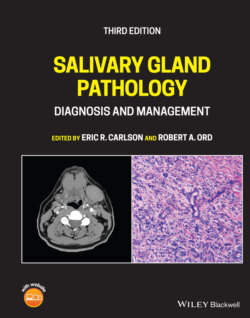Читать книгу Salivary Gland Pathology - Группа авторов - Страница 77
RADIONUCLIDE IMAGING (RNI)
ОглавлениеRadionuclide imaging (RNI) has, throughout its history, been a functional imaging modality without the quality of anatomic depiction when compared with CT, MRI, or even US. Most radionuclide imaging has been performed with planar imaging systems, which produce single view images of functional processes. All RNI exams employ a radioactive tracer either bound to a ligand (radiopharmaceutical) or injected directly (radionuclide). As the radionuclide undergoes radioactive decay, it emits either a gamma ray (photon), and/or a particle such as an alpha particle (helium nucleus), beta particle (electron), or a positron (a positively charged electron). Gamma rays differ from X‐rays in that, gamma rays (for medical imaging) are an inherent nuclear event and are emitted from the nucleus of an unstable atom to achieve stability. X‐rays (in the conventional sense) are produced in the electron cloud surrounding the nucleus. In medical imaging, X‐rays are artificially or intentionally produced on demand, whereas gamma rays (and other particles) are part of an ongoing nuclear decay, enabling unstable radioactive atoms to reach a stable state. The length of time it takes for one half of the unstable atoms to reach their stable state is called their half‐life. Radionuclide imaging involves the emission of a photon that is imaged using a crystal or solid‐state detector. The detector may be static and produces images of the event in a single plane or the detector may be rotated about the patient to gather three‐dimensional data and reconstruct a tomographic image in the same manner as a CT scanner. This is the basis for single photon emission computed tomography (SPECT). Examples of planar images used in salivary gland diseases include gallium (67Ga) for evaluation of inflammation, infection, and neoplasms (lymphoma). SPECT, which produces tomographic cross‐sectional images, is less commonly used in oncologic imaging, although novel radionuclides and ligands are under investigation. The recent introduction of SPECT/CT, a combined functional and anatomic imaging machine may breathe new life into SPECT imaging.
